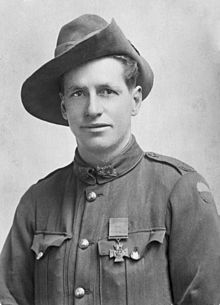James Park Woods | |
|---|---|
 Woods c. 1918–1919 | |
| Nickname(s) | Jimmy |
| Born | 4 January 1886 Two Wells, South Australia |
| Died | 18 January 1963 (aged 77) Nedlands, Western Australia |
| Buried | |
| Allegiance | Australia |
| Service | Australian Imperial Force |
| Years of service | 1916–1919 |
| Rank | Private |
| Unit | 48th Battalion |
| Battles / wars | |
| Awards | Victoria Cross |
| Other work | Vigneron |
James Park Woods VC (4 January 1886 – 18 January 1963) was an Australian recipient of the Victoria Cross during World War I; the Victoria Cross was the highest award for gallantry in the face of the enemy that could be awarded to members of the Australian armed forces at the time. Woods enlisted in the Australian Imperial Force in September 1916 and, after training in Australia and the United Kingdom, joined his unit, the 48th Battalion, in France in September 1917. Along with the rest of his battalion, he participated in the First Battle of Passchendaele the following month. In early 1918, Woods was hospitalised for several months before rejoining his unit in May. He again reported sick in July, and did not return to the 48th Battalion until mid-August.
On 18 September 1918, the 48th Battalion was involved in the attack on the Hindenburg Outpost Line during the Hundred Days Offensive. After the first phase of the attack, some elements of Woods' unit were tasked to support another battalion as it conducted a further assault. When it was suspected that flanking British troops had not gone forward to their objective as reported, a four-man patrol including Woods attempted to make contact with them. Instead of finding British troops, they encountered a strong German post and, after calling for reinforcements, attacked it, driving more than thirty Germans from the position. Woods' actions during this assault and subsequent defence of the captured post resulted in him being awarded the Victoria Cross. Woods survived the war, returned to Australia and operated a vineyard and orchard in Western Australia. He retired early due to ill health and died in 1963. His medals are displayed in the Hall of Valour at the Australian War Memorial.